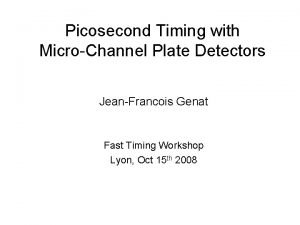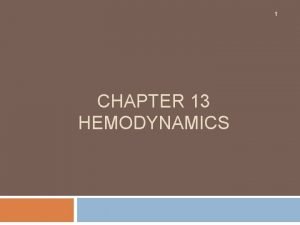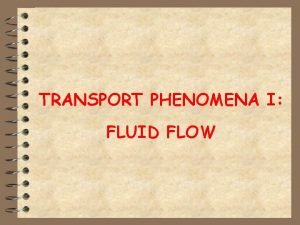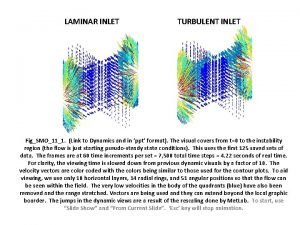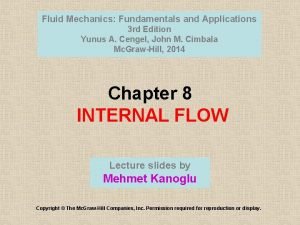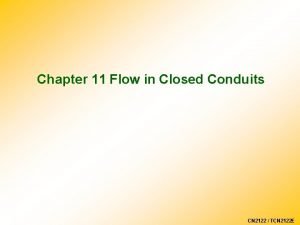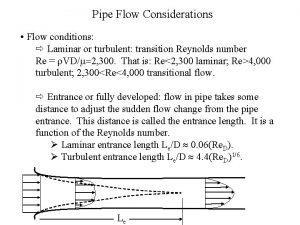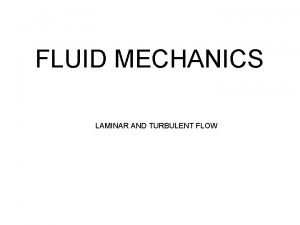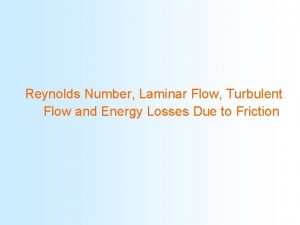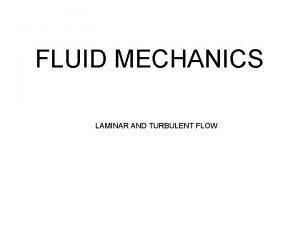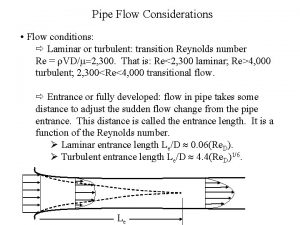1 Laminar flow 1 pt a A microchannel











- Slides: 11

1. Laminar flow (1 pt. ) a) A microchannel with a square cross section (200μm x 200μm) has a volumetric flow (water) rate of 10 μl/min. Estimate whether the flow is laminar or turbulent by calculating the Reynolds number. b) You are swimming in water. Estimate whether the flow around you is turbulent of laminar by calculating the Reynolds number. V=Q/A a) < 1 so the flow is definitely laminar. Note that this is a quite large channel with very fast flow. (You could also use hydraulic radius instead of diameter, diameter is slightly more correct) b) Estimate your swimming speed and characteristic dimension. . . . as you can see, no matter what kind of swimmer you are, the flow will be turbulent.

Points about cross sectional dimensions, channel length and the parameter “L” • • When you have a channel, it is a 3 D object with length, width and height (or depth). The height and width dimensions form the cross section, because the fluid flow is perpendicular to this plane. Apart from gravity, which is most often negligible, there is no difference between height and width. (from the point of view of fluidic phenomena, fabrication is often totally different) On this course so far, the cross sectional parameters are the ones that will be used for calculating Reynolds number, Bond number, hydraulic radius and the R^4 or the w^3*h or h^3 * w component of the hydraulic resistance. The length of the channel appears only as a linear term L in the hydraulic resistance calculation. A source of confusion: I have presented both the “characteristic length scale” for dimensionless numbers and also the length of the microchannel for Hagen. Poiseuille as a capital L. Watch out, these two are NOT at all the same thing. In Hagen-Poiseuille the L is the length of the channel. In other contexts, it is the characteristic dimension of the channel that is calculated from the cross section (width and height) through e. g. the hydraulic diameter.

2. Microfluidic circuit (3 pts. ) A microfluidic chip consists of an inlet, an outlet, two 20 microns wide channel segments and a 500 microns wide reaction chamber as shown in the picture (top view). The channel depth throughout the chip is 80 μm and the lengths and widths of the three segments have been marked to the picture. The liquid used on the chip is water at 20°C (μ= 1 m. Pa*s). a) Calculate the fluidic resistance of the chip using two methods. First, calculate using the hydraulic radius approximation. Second, calculate the flow resistance according to: b) Calculate the volumetric flow rate (in μl/min) when a 1000 Pa pressure difference is applied between the inlet and the outlet. Use the flow resistance calculated according to the formula in a), and not the hydraulic radius approximation. a) Hydraulic radius approximation: Hydraulic radii of the elements: hint: pay attention to the units Flow resistances of the elements: Total flow resistance of a series: RH=RH 1+RH 2+RH 3≈430 000 Pas / mm 3

a) Better approximation: when h<w when w<h How to deduce this? What separates the width of the channel from the height? Only gravity. But gravity is negligent most of the time in microfluidics, and definitely with the dimensions of this exercise. Additional hint: RH becomes negative otherwise, and it cannot be negative. Total flow resistance of a series: RH=RH 1+RH 2+RH 3≈240 000 Pas / mm 3

b) Hagen-Poiseuille: The average linear velocity vave = Q/A ≈ 2. 6 mm/s on the narrow part and 0. 1 mm/s for the broad.

3. Capillary filing (3 pts. ) a) A microfluidic channel has a rectangular cross section of 20 µm x 20 µm and the water contact angle is 20°. What is the bond number (when the channel is in a horizontal orientation)? What is the capillary pressure? If the channel was of infinite length and was turned vertically, how high would the liquid rise against gravity? b) A microfluidic channel has a cross section and contact angles as depicted below. What is the maximum width/height ratio that still leads to spontaneous capillary filling? Bond: (when the channel is in a horizontal orientation) <- what is that part about? ? Bond number is sensible when the characteristic length scale for hydrostatic pressure x is the same as the characteristic length scale for capillary pressure R. On a horizontal orientation, both are close to the height of the microchannel. On a vertical orientation, capillary length scale remains the same but hydrostatic pressure is instead characterized the vertical length of the whole chip!

Capillary pressure: 20° 20° 20µm Height: 1 mm of water is ≈ 10 Pa Fun tidbit: the dimensions in this exercise are not unlike the xylem in trees.

b) careful here!, which θ: s go with which dimensions R 1 R 2 note: both sign conventions for capillary pressure are in use in the literature. note: cos 120° + cos 70° < 0

Capillary pressure sign conventions “Physicist point of view”: P = atm + ΔP P = atm “Microfluidic engineer point of view”: P = atm + ΔP P = atm Either way, the pressure gradient in the channel is the same.

4. Surface energy, adhesion, contact angle (1 pt. ) A liquid droplet sits on top of a solid surface, surrounded by air ambient. The work of adhesion between the liquid and the solid is exactly half of the work of cohesion of the liquid. What is the contact angle? Definitions of cohesion, adhesion and Young’s Equation: Insert into Young’s: If cohesion = adhesion, θ=0°, (completely wetting) If adhesion = 0, θ=180°, (ideal superhydrophobicity)

Young’s equation and adhesion, number of independent parameters: On first sight, these two equations contain 4 parameters each. However, since the solid surface is unable to deform, γsv + γsl = constant. In wetting phenomena, we are only interested in changes, which is why the 2 solid surface energy terms only ever appear in the term (γsv - γsl) and not independently. So in reality, both wetting related equations have only 3 independent terms. This is good news since both γlv and cos(θ) are easily measurable, and measuring 2/3 of independent parameters is enough to know everything about the system. Young’s equation and adhesion, Young dupré equation: This is called the Young-Dupré equation, and it relates the work of adhesion to the surface tension and contact angle. You can test what happens to adhesion when θ=0, 90 or 180 degrees. Compare the results to the equation for the work of cohesion.


